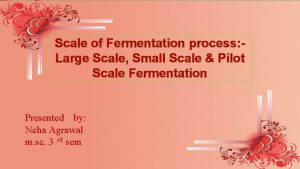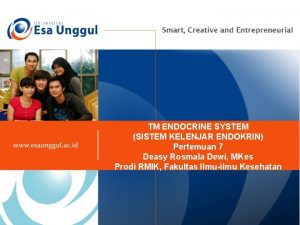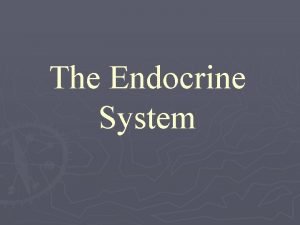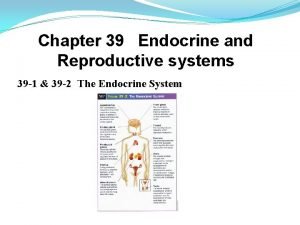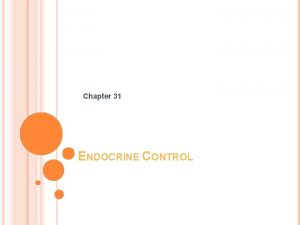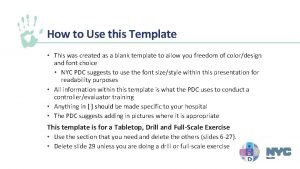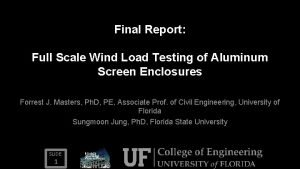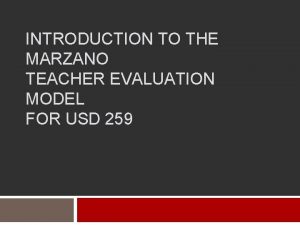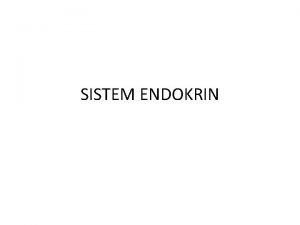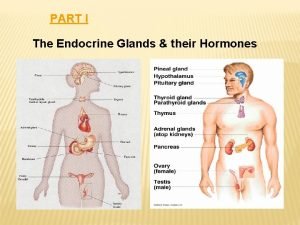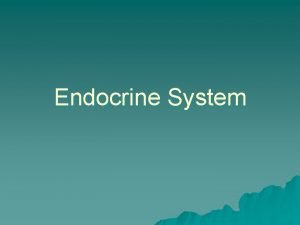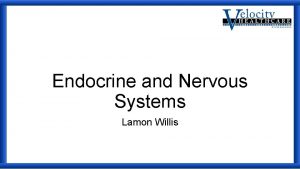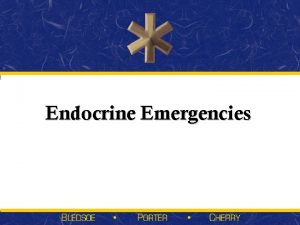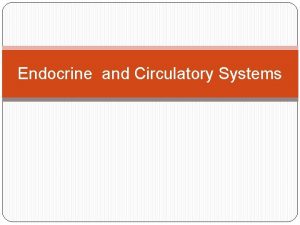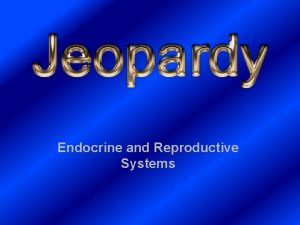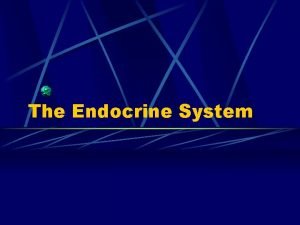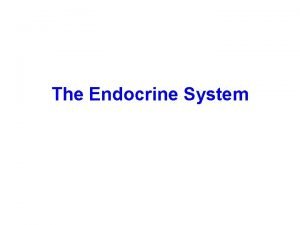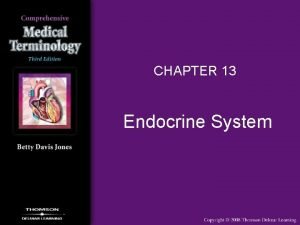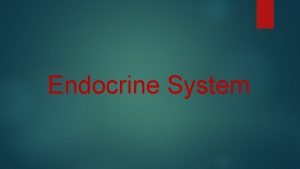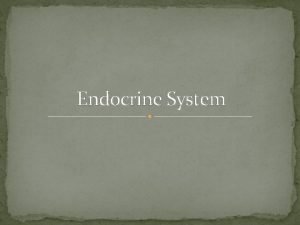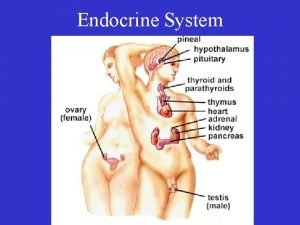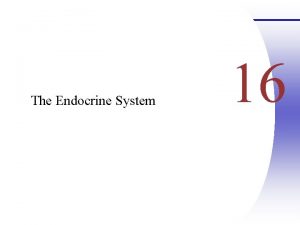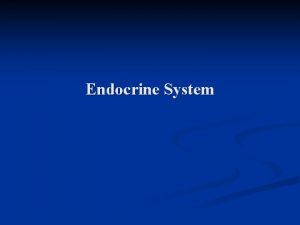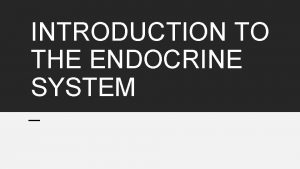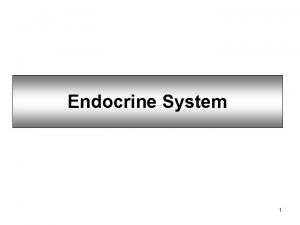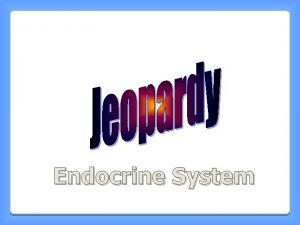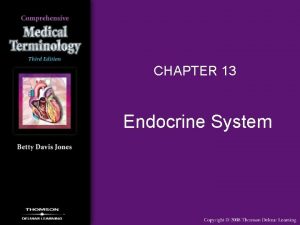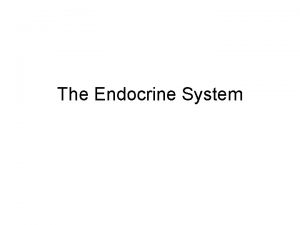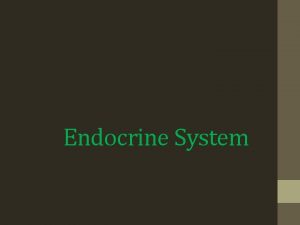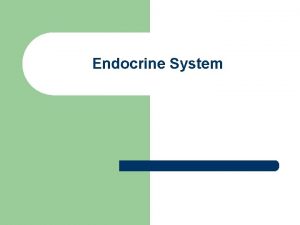Full Scale and Pilot Scale Evaluation of Endocrine





























- Slides: 29

Full Scale and Pilot Scale Evaluation of Endocrine Disrupting Compound Removal Through WTP Processes Bob Raczko, P. E. United Water

PRESENTATION OUTLINE Background information Research projects: – Water Research Foundation (WRF) – United WERCs WRF project United WERCs project Summary 2

EDCs and PPCPs • EDCs - endocrine disrupting chemicals • PPCPs - pharmaceuticals and personal care products • Includes wide range of daily-use products Pharmaceuticals Personal care products Pesticides Surfactants Plasticizers PAHs • Manmade sources - synthetic chemicals • Detected at ug/L and ng/L levels 3

Putting Things in Perspective 1 ppb or 1 ug/L 1 ppt or 1 ng/L X 1, 000 4

Toxicological Relevance of PPCPs and EDCs Carbamazepine Triclosan Sulfamethoxazole Trimethoprim Phenytoin Diclofenac Naproxen Gemfibrozil Estradiol 5 Drinking Water Equiv. Level (ug/L) Max. Finished Water Level (ug/L) 12 2, 600 18, 000 6, 700 6. 8 2, 300 20, 000 45 0. 58 0. 018 0. 0012 0. 003 <0. 00025 0. 032 <0. 00025 <0. 0005 0. 0021 <0. 0005

Research Projects – Endocrine Disrupting Compounds (EDCs) and Pharmaceuticals and Personal Care Products (PPCPs) Water Research Foundation (WRF) – Removal of Unregulated Organic Chemicals in Full-Scale Water Treatment Processes United WERCs – Advanced Pilot Testing of Treatment Processes for Removal of EDCs and PPCPs 6

Water. RF Project Sponsoring Utility: Passaic Valley Water Commission, NJ Principal Investigator: Black & Veatch, consulting engineer Co-PIs: Catherine Spencer, Black & Veatch Dr. Judy Louis, NJDEP Utility Participants: UWNJ, UWRahway, Brick Township Objective: Investigate the effectiveness of full-scale conventional and advanced water treatment processes for removal of endocrine disrupting compounds. 7

WRF Project - Research Approach Sample each treatment plant 4 times – spring/summer/fall/winter Collect samples after each unit treatment process Samples were analyzed by USGS laboratory Analyze for over 100 compounds Pilot testing using Haworth pilot plant - United WERCs project Prepare project report summarizing the findings 8

United WERCs - Research Approach Participants - United Water and NJIT Overall – supplement WRF project by obtaining additional performance data for a variety of conventional and advanced water treatment processes on the removal efficiency of EDCs and PPCPs from drinking water supplies. Specific objectives: – – – Identify select unregulated compounds to investigate Spike the Haworth pilot plant influent with the select compounds Follow these compounds through the pilot plant unit treatment processes Evaluate their removal and degradation as a function of treatment process Evaluate potential synergies in treatment processes 9

Water. RF Project Findings Contaminants and levels varied – – Round 1 2 3 4 (May 2010) – 23 raw water compounds (August 2010) – 20 raw water compounds but not the same as Round 1 (March 2011) – 30 raw water compounds, many not found prior (July 2011) - 30 raw water compounds, some not found prior Classes of compounds found – – – – Pharmaceuticals, few antibiotics, ingested metabolites Flame retardants Fragrance, flavor Topically applied compounds PAHs Pesticides Solvents/plasticizers Detergents (nonyl- and octylphenols) 10

Conclusions from the Data Large range in concentration and types of compounds found with precipitation/source volume, seasonal patterns Would be very difficult to regulate using a contaminant -by-contaminant approach Advanced oxidation, especially post-coagulation, effective for oxidation/conversion of many aromatics, alkanes, and cyclic organics GAC adsorption of more non-polar compounds (PAHs, flavor and fragrance compounds, many pharmaceuticals) 11

12 Nanograms/liter

13 Nanograms/liter

Tris(dichloroisopropyl) phosphate 3500 Tris(2 -chloroethyl) phosphate Tris(2 -butoxyethyl) phosphate Triphenyl phosphate 3000 Triethyl citrate Tributyl phosphate Tetrachloroethene 2500 Pyrene Phenanthrene Isophorone 2000 Nanograms/liter Fluoranthene Cotinine Caffeine 1500 Benzophenone Anthracene 9, 10 -Anthraquinone 1000 4 -tert-Octylphenol 4 -Nonylphenol (sum of all isomers) Prometon 500 Metolachlor DEET Carbazole 0 Plant B - Raw Plant B Filtered Plant B - Post GAC 14 Plant B Finished Carbaryl Bromacil

Plant B Process Performance Removal Category Polycyclic Aromatic Hydrocarbons 100% after filtration or GAC Pesticides chloroacetanilide triazine uracil type solvent Variable 66% after GAC Bind weakly to GAC? 100% after GAC Fragrance compound 100% after aeration Topically applied - DEET 41 – 75% after GAC and chlorine Metabolites caffeine cotinine cholesterol 0 – 65% after GAC <20% in finished water 100% post aeration Pharmaceuticals/Antibiotics Flame retardants – only 1 of 3 removed Plasticizer 100% after GAC <10% (2) 100% (1) after GAC 100% removed by filtration Volatile 88 – 100% after aeration 15

16 Nanograms/liter

Plant D Process Performance 17

United WERCs Project Elements Task 1 - Preliminary Investigations – – Literature Review Surrogate or indicator parameters Other treatment processes Technical Memorandum - deliverable Task 2 - Pilot Tests – Initial pilot runs – Memorandum - deliverable – Additional pilot runs Task 3 - Report Preparation – Draft report - deliverable – Final report - deliverable 18 May-December 2010 November 2010 April 2011 – July 2011 June 2011 September - December 2011 November 2011 December 2011

Priority Indicator Compounds (12 Groups, 16 Compounds) Classes Compounds Analgesics Acetaminophen Ibuprofen Antibiotics Erythromycin Sulfamethoxazole Trimethoprim Antidepressants Diazepam Antiepileptic Carbamazepine Beta-Blockers Atenolol Blood Lipid Regulators Gemfibrozil Fire Retardant Tris(2 -chloroethyl)phosphate (TCEP) Nicotine Metabolite Cotinine Pesticides Atrizine N, N-Diethyl-meta-toluamide (DEET) Psychomotor Stimulant Caffeine Steroids 17 β-Estradiol X-ray Contrast Agent Iopromide 19

Pilot Plant Flow Diagram Train B – O 2/UGAC Train A – O 2/VGAC Train C – UV/H 2 O 2 20

Results of Ozone Tests Note: 1. Number in each box denotes number of compounds removed at given percentage. Removal Pre-Ozone Pre. Ozone/H 2 O 2 Intermediate Ozone/H 2 O 2 > 90% 7 3 5 6 75 – 90 % 1 2 1 3 75 – 99 % 8 5 6 9 50 – 75 % 2 2 2 0 < 50 % 5 8 7 6 0 – 75 % 7 10 9 6 21

Results of GAC Tests Note: 1. Number in each box denotes number of compounds removed at given percentage. Removal Virgin GAC Used GAC > 90% 13 2 75 – 90 % 0 2 75 – 99 % 13 4 50 – 75 % 0 3 < 50 % 2 8 0 – 75 % 2 11 22

Results of Ozone/GAC Tests Note: 1. Number in each box denotes number of compounds removed at given percentage. Removal > 90% Pre-Ozone Virgin GAC Pre-Ozone Used GAC Inter. Ozone Virgin GAC Inter. Ozone Used GAC 131 ND - 9 7 ND - 2 15 ND - 13 8 ND - 4 75 – 90 % 2 1 0 2 75 – >99 % 15 8 15 10 50 – 75 % 0 1 0 3 < 50 % 0 6 0 2 0 – 75 % 0 7 0 5 23

Results of UV/H 2 O 2 Tests Note: 1. Number in each box denotes number of compounds removed at given percentage. (H 2 O 2 – mg/L) (UV – m. J/Sq cm) Removal UV – 500 H 2 O 2 - 20 UV - 500 H 2 O 2 - 15 UV - 700 H 2 O 2 - 15 UV – 700 H 2 O 2 - 15 > 90% 6 7 12 12 75 – 90 % 3 2 1 1 75 – 99 % 9 9 13 13 50 – 75 % 1 1 1 0 < 50 % 5 5 1 2 0 – 75 % 6 6 2 2 24

Overall Test Results Removal Note: 1. Number in each box denotes number of compounds removed at given percentage. Pre. Ozone Intermediate Ozone/H 2 O 2 Virgin GAC Intermediate Ozone/VGAC UV/H 2 O 2 700/15 > 90% 71 6 13 15 ND - 13 12 ND - 9 75 – 90 % 1 3 0 0 1 75 – 99 % 8 9 13 15 13 50 – 75 % 2 0 0 0 1 < 50 % 5 6 2 0 1 0 – 75 % 7 6 2 0 2 25

Treatability of Indicator Compounds Good (75%) to Very Good (>90%) Acetaminophen Ibuprofen Sulfamethoxazole Trimethoprim Carbamazepine Atenolol Gemfibrozil Atrazine DEET Caffeine 17β-Estradiol Iopromide 26 Fair (50%) to Poor (<50%) Erythromycin TCEP Cotinine DEET Caffeine 17β-Estradiol Iopromide Indicates removal dependent on treatment process “Good to Very Good” and “Fair to Poor” applies to all treatment processes.

Treatment Issues/Concerns Ozone - potential by-products formed GAC - carbon usage rate (or length of run) UV/H 2 O 2 - potential by-products formed 27

Summary Advanced processes (oxidation, AOP, GAC) most effective AOP - UV/H 2 O 2 - may not be practical Future work – – – Range of effective dosages for ozone Range of dosages for ozone and H 2 O 2 GAC contact time and usage rate By-product formation Confirm indicator compounds 28

THANK YOU! Any Questions?
 Pilot scale fermentation
Pilot scale fermentation Endocrine medical term
Endocrine medical term Major endocrine glands male and female
Major endocrine glands male and female Endocrine system organs
Endocrine system organs Endocrine system and reproductive system
Endocrine system and reproductive system Differences between nervous system and endocrine
Differences between nervous system and endocrine Comparison of endocrine and nervous system
Comparison of endocrine and nervous system Difference between endocrine and exocrine glands
Difference between endocrine and exocrine glands Chapter 46 digestive and endocrine disorders
Chapter 46 digestive and endocrine disorders Oxication
Oxication Chapter 39 endocrine and reproductive systems
Chapter 39 endocrine and reproductive systems Chapter 29 endocrine and metabolic disorders
Chapter 29 endocrine and metabolic disorders Endocrine and hematologic emergencies
Endocrine and hematologic emergencies Endocrine and nervous system comparison
Endocrine and nervous system comparison Whats the difference between endocrine and exocrine glands
Whats the difference between endocrine and exocrine glands Endocrine system
Endocrine system Endocrine system and nervous system
Endocrine system and nervous system Chapter 45 hormones and the endocrine system
Chapter 45 hormones and the endocrine system Exercise evaluation guide template
Exercise evaluation guide template Engineering drawing conventions
Engineering drawing conventions Full scale load testing
Full scale load testing Danielson and marzano
Danielson and marzano Marzano teacher evaluation
Marzano teacher evaluation Endokrin dan eksokrin
Endokrin dan eksokrin Adenohypophysis
Adenohypophysis Portal circulation
Portal circulation Endocrine anatomy
Endocrine anatomy Steroids endocrine system
Steroids endocrine system Endocrine system fact
Endocrine system fact Lympathic
Lympathic
